Family: Argidae
Family common name: argid sawflies
Subfamily: Sterictiphorinae
Genus: Neoptilia Ashmead, 1898
Subgenera: none
Argidae are found in all non-polar regions of the world (Smith and Middlekauff 1987Smith and Middlekauff 1987:
Smith DR and Middlekauff WW. 1987. Suborder Symphyta. In: Stehr FW ed. Immature Insects. Kendall/Hunt Publishing Company. Vol. 1: 754 pp., Smith 1992Smith 1992:
Smith DR. 1992. A synopsis of the sawflies (Hymenoptera: Symphyta) of America south of the United States: Argidae. Memoirs of the American Entomological Society 39: 1-201.). They are external foliage feeders with a wide range of host plants. The family exhibits some uncommon behaviors like the excretion of defensive compounds and subsocialsubsocial:
Living in aggregations but lacking organizational structure as in true social insects; can describes insects with tendencies to protect or care for thier young, feed gregariously, and build cocoon masses.
habits (Smith 1992Smith 1992:
Smith DR. 1992. A synopsis of the sawflies (Hymenoptera: Symphyta) of America south of the United States: Argidae. Memoirs of the American Entomological Society 39: 1-201.)
Neoptilia are about 10–12 mm in length, and in North America are generally red and black. They are recognized by coloration, small eyes, and characteristic 3-segmented antennaeantenna:
the sensory organ emerging from the front of the head, usually between the compound eyes and above the clypeus; includes the flagellum, scape and pedicel
 , which in males are distinctly forked (Smith 1971cSmith 1971c:
, which in males are distinctly forked (Smith 1971cSmith 1971c:
Smith DR. 1971c. Nearctic sawflies of the genera Neoptilia Ashmead, Schizocerella Forsius, Aprosthema Konow, and Sphacophilus Provancher (Hymenoptera: Argidae). Transactions of the American Entomological Society 97: 537-594., Smith 1992Smith 1992:
Smith DR. 1992. A synopsis of the sawflies (Hymenoptera: Symphyta) of America south of the United States: Argidae. Memoirs of the American Entomological Society 39: 1-201., Vikberg 2004Vikberg 2004:
Vikberg V. 2004. Seasonal head dimorphism and taxonomy of some European species of Aprosthema (Hymenoptera: Symphyta: Argidae). Beitrauml;ge Zur Entomologie 54 (1): 107-125. https://doi.org/10.21248/contrib.entomol.54.1.107-125).
There are 10 species described worldwide, all restricted to the Americas. Eight species are recorded from North America (Taeger et al. 2010Taeger et al. 2010:
Taeger A, Blank SM, and Liston AD. 2010. World Catalog of Symphyta (Hymenoptera). Zootaxa 2580: 1-1064.).
A key to North American species of Neoptilia is included in Smith 1971cSmith 1971c:
Smith DR. 1971c. Nearctic sawflies of the genera Neoptilia Ashmead, Schizocerella Forsius, Aprosthema Konow, and Sphacophilus Provancher (Hymenoptera: Argidae). Transactions of the American Entomological Society 97: 537-594..
 (Smith 1992Smith 1992:
(Smith 1992Smith 1992: less than width of cenchruscenchrus:
less than width of cenchruscenchrus: (Smith 1992Smith 1992:
(Smith 1992Smith 1992: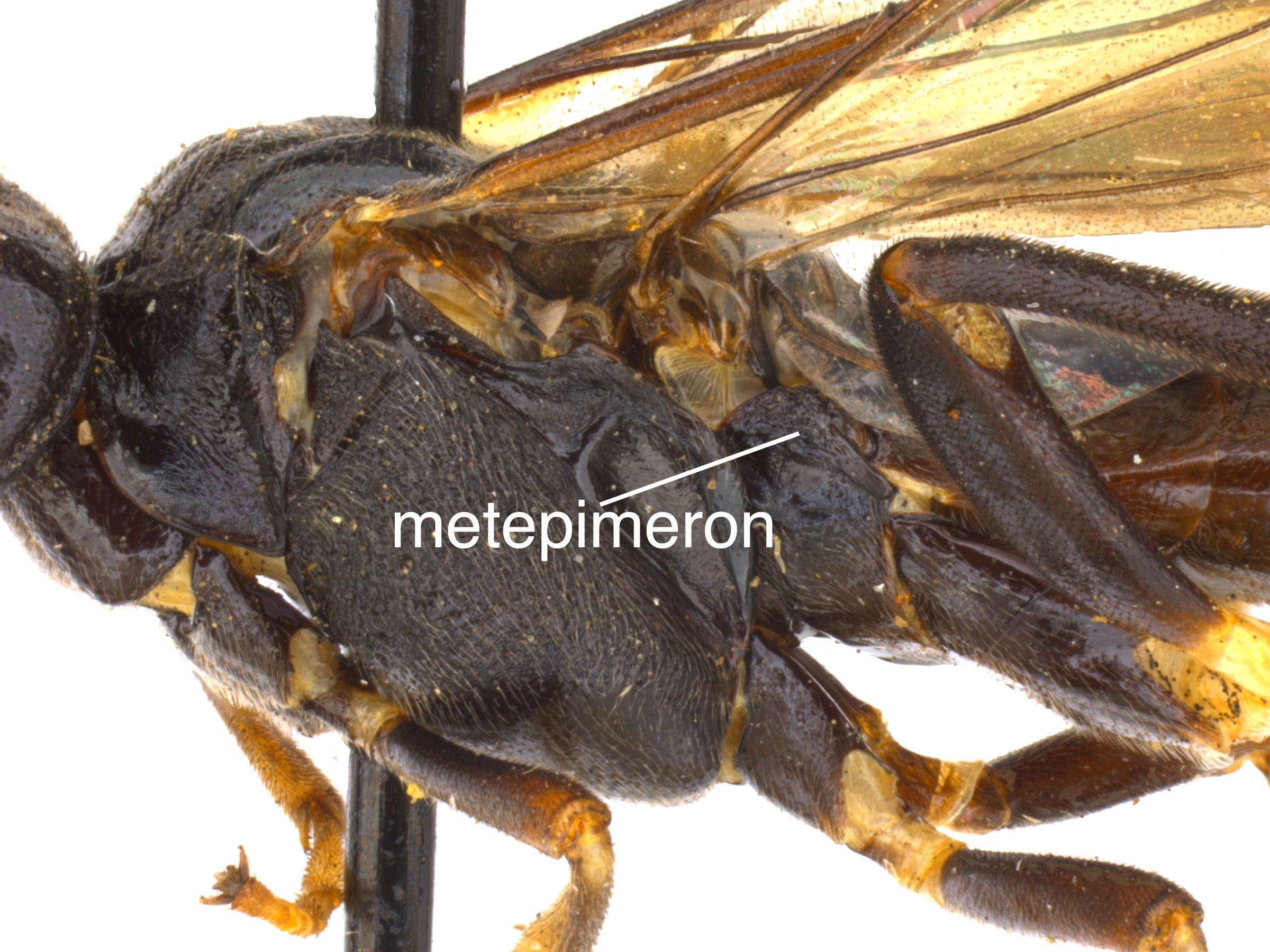 fused laterally with first tergitetergite:
fused laterally with first tergitetergite: (Smith 1992Smith 1992:
(Smith 1992Smith 1992: R closed at apexapex:
R closed at apexapex: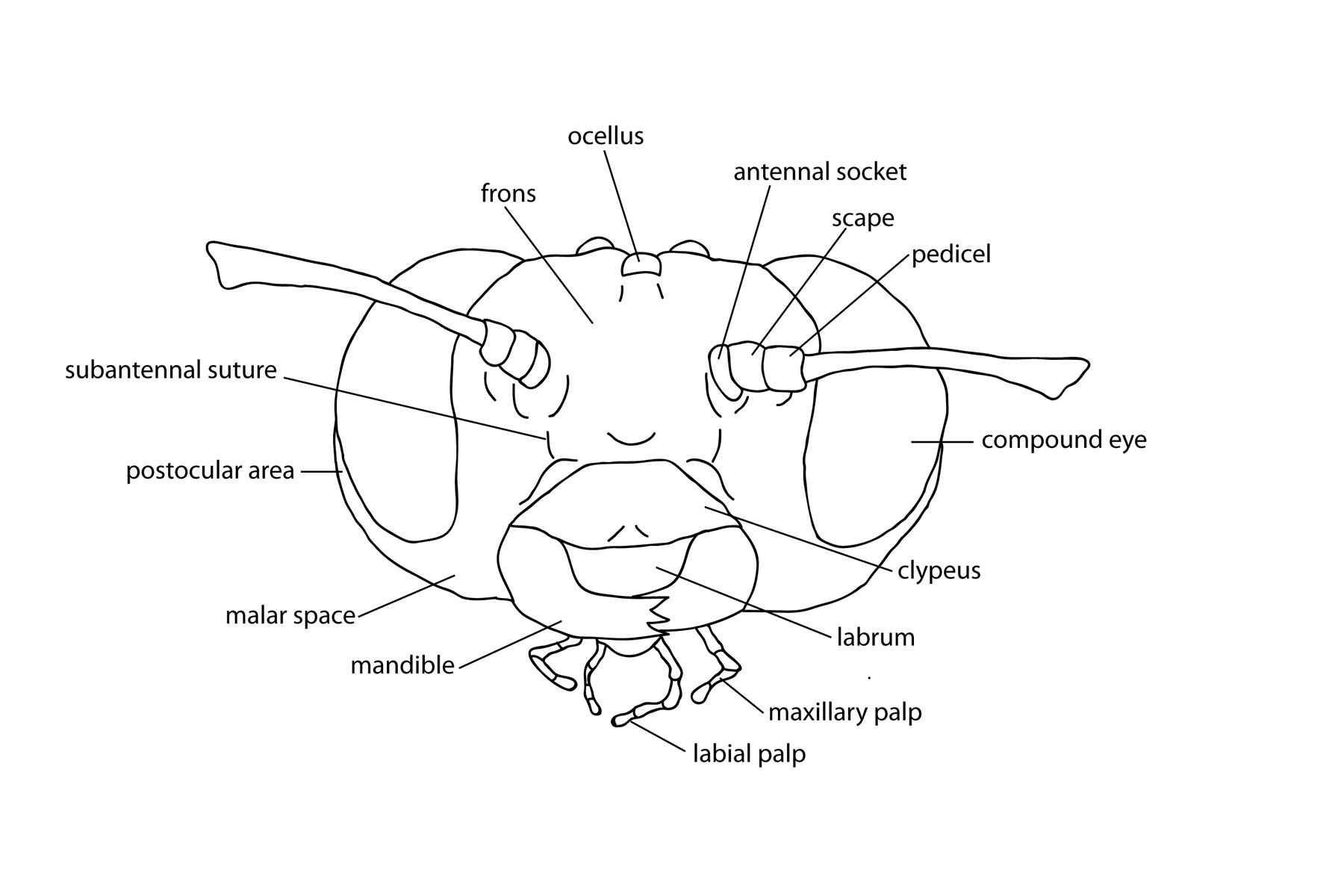 (Smith 1992Smith 1992:
(Smith 1992Smith 1992: with a long inner tooth; lacking a basalbasal:
with a long inner tooth; lacking a basalbasal:The family Argidae can be readily identified by the single-segmented flagellumflagellum:
the third section of the antennae that includes all the segments beyond the pedicel; segments of the flagellum are known as flagellomeres
 of the antennaantenna:
of the antennaantenna:
the sensory organ emerging from the front of the head, usually between the compound eyes and above the clypeus; includes the flagellum, scape and pedicel
 . The genus Neoptilia can be distinguished from other genera in the family by the lack of preapicalpreapical:
. The genus Neoptilia can be distinguished from other genera in the family by the lack of preapicalpreapical:
close to, but anterior to, the apex
 spurs on the tibiaetibia:
spurs on the tibiaetibia:
the fourth segment of the leg, between the femur and the tarsus
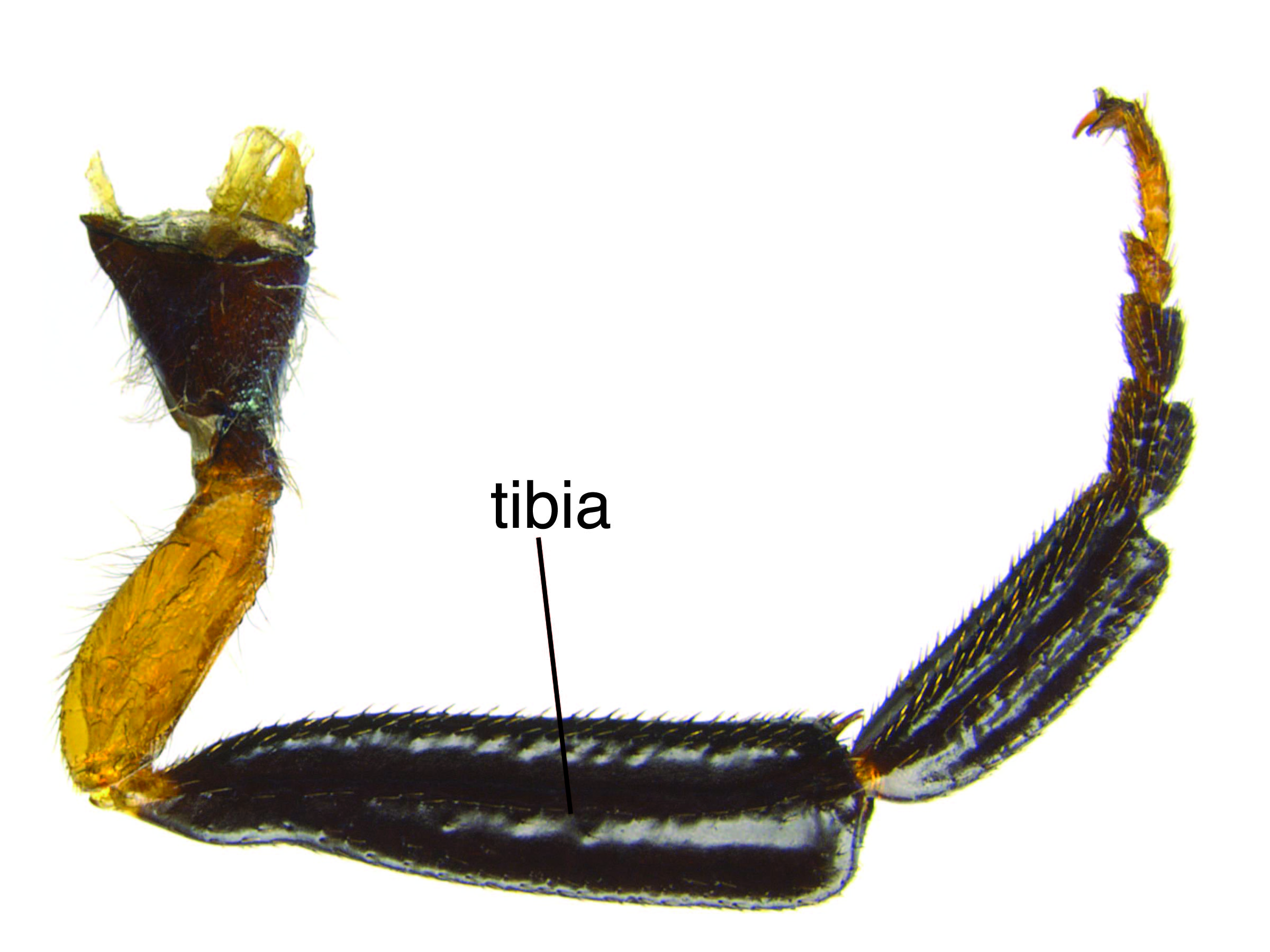 , the bifidbifid:
, the bifidbifid:
divided or forked into two branches or parts
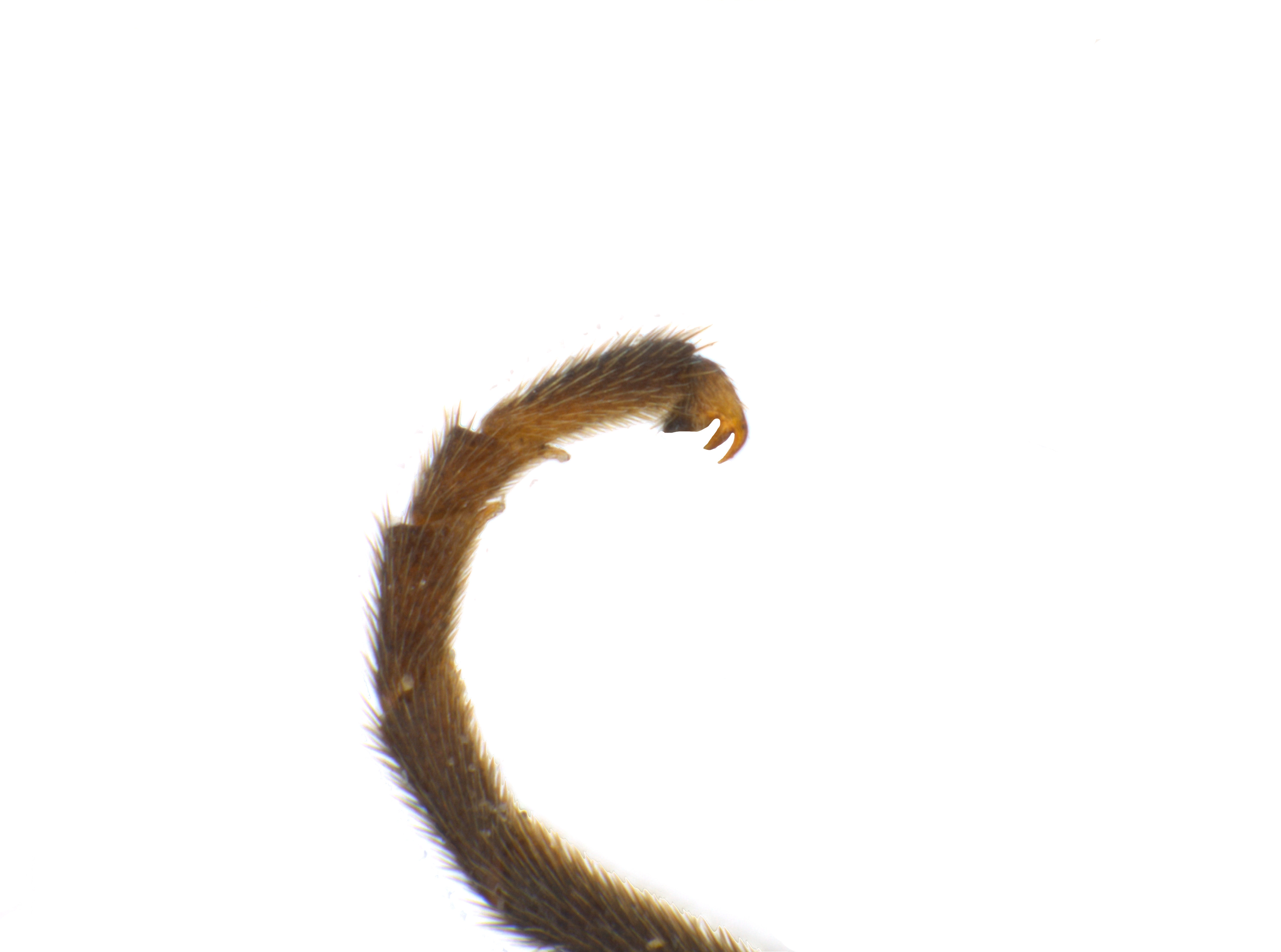 tarsal claws, and a lack of veinvein:
tarsal claws, and a lack of veinvein:
a tube-like, often darkened, structure on the wings
 Sc in the fore wingfore wing:
Sc in the fore wingfore wing:
the anterior wing of each pair of wings; usually the largest wing of the pair
 . Males are distinguished from related genera Arge and Atomacera by the conspicuous forked antennaeantenna:
. Males are distinguished from related genera Arge and Atomacera by the conspicuous forked antennaeantenna:
the sensory organ emerging from the front of the head, usually between the compound eyes and above the clypeus; includes the flagellum, scape and pedicel
 (Smith 1992Smith 1992:
(Smith 1992Smith 1992:
Smith DR. 1992. A synopsis of the sawflies (Hymenoptera: Symphyta) of America south of the United States: Argidae. Memoirs of the American Entomological Society 39: 1-201.).
Neoptilia are unique in the Argidae by the fused harpesharpes:
structure emerging posterolaterally from the external male genitalia
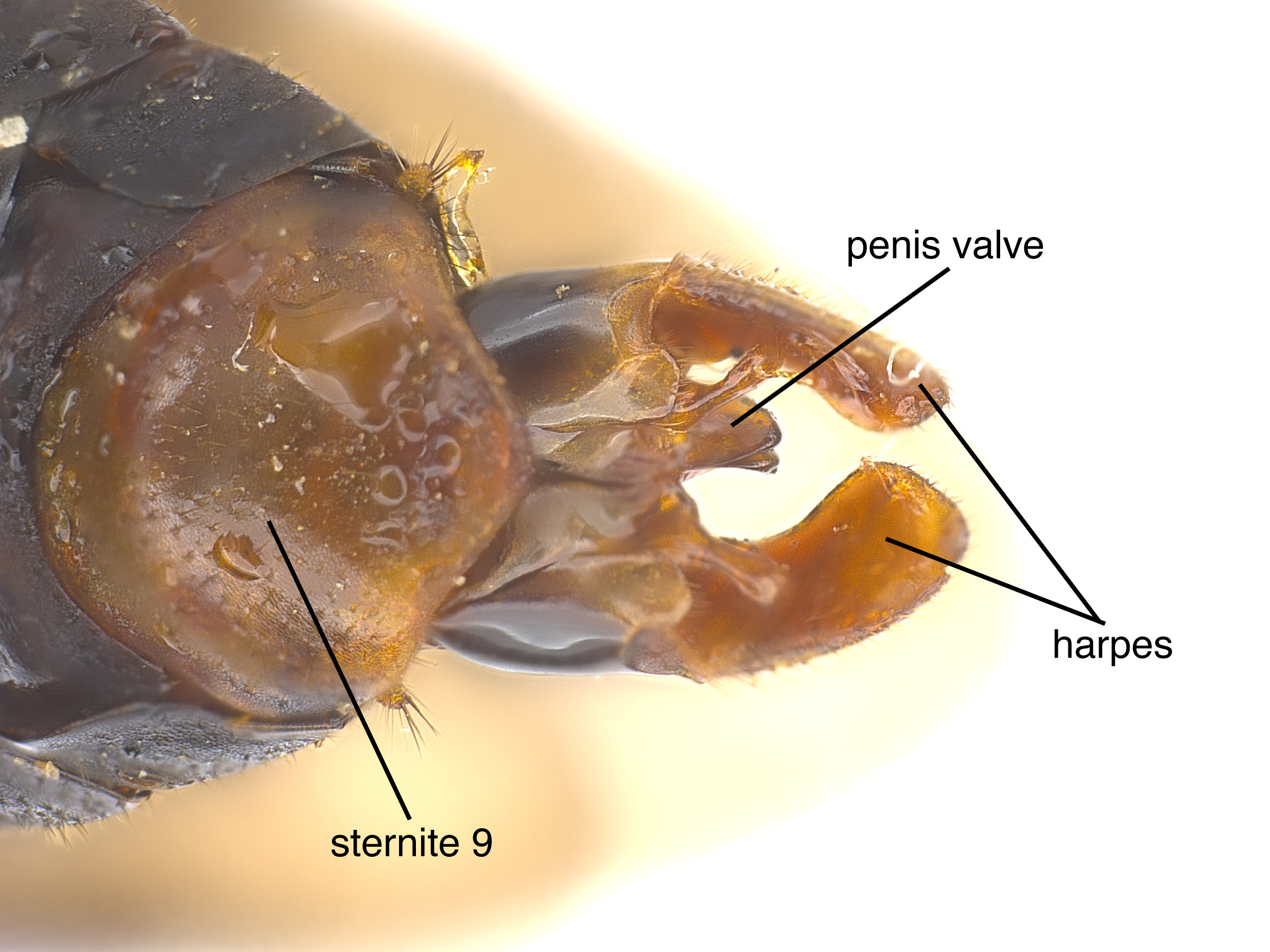 and gonostipes of the male genitalia, but dissection is usually necessary to observe this character (Smith 1971cSmith 1971c:
and gonostipes of the male genitalia, but dissection is usually necessary to observe this character (Smith 1971cSmith 1971c:
Smith DR. 1971c. Nearctic sawflies of the genera Neoptilia Ashmead, Schizocerella Forsius, Aprosthema Konow, and Sphacophilus Provancher (Hymenoptera: Argidae). Transactions of the American Entomological Society 97: 537-594.).
none
Larvae are external leaf feeders on Malvaceae. Recorded hosts include: Alcea rosea (hollyhock), Malvastrum sp. (false mallow), Malva sp. (mallow), Sphaeralcea angustifolia (copper globemallow), Bastardiopsis densiflora, Allowissadula holosericea (velvetleaf mallow), and Abutilon fruticosum (Indian mallow) (Smith 1992Smith 1992:
Smith DR. 1992. A synopsis of the sawflies (Hymenoptera: Symphyta) of America south of the United States: Argidae. Memoirs of the American Entomological Society 39: 1-201., Bugh 2015Bugh 2015:
Bugh V. 2015. The mystery of the purple larvae. Austin Bug Blog. Accessed 2019. http://austinbug.com/larvalbug/val/archval9-15.html, BugGuide 2019BugGuide 2019:
BugGuide. Accessed January 2019. https://bugguide.net).
The female oviposits along the margin of the leaf. After hatching the larvaelarva:
the immature stage of holometabolous insects
 are external feeders on the foliage of a plant, sometimes gregariously, sometimes singly (Smith 1989Smith 1989:
are external feeders on the foliage of a plant, sometimes gregariously, sometimes singly (Smith 1989Smith 1989:
Smith DR. 1989. The sawfly genus Arge (Hymenoptera: Argidae) in the Western Hemisphere. Transactions of the American Entomological Society 115: 83-205.). LarvaeLarva:
the immature stage of holometabolous insects
 are caterpillar-like, with variable coloration patterns and usually body ornamentation in the form of tubercles or setaeseta:
are caterpillar-like, with variable coloration patterns and usually body ornamentation in the form of tubercles or setaeseta:
hair-like structure
(Smith and Middlekauff 1987Smith and Middlekauff 1987:
Smith DR and Middlekauff WW. 1987. Suborder Symphyta. In: Stehr FW ed. Immature Insects. Kendall/Hunt Publishing Company. Vol. 1: 754 pp.). Late instar N. tora larvaelarva:
the immature stage of holometabolous insects
 are distinctively bright purple in color (Bugh 2010Bugh 2010:
are distinctively bright purple in color (Bugh 2010Bugh 2010:
Bugh V. 2010. Riddle of the purple sawfly larvae. Newsletter of the Austin Butterfly Forum March-April-May 2010., BugGuide 2019BugGuide 2019:
BugGuide. Accessed January 2019. https://bugguide.net) and N. malvacearum are red or orange (Smith 1992Smith 1992:
Smith DR. 1992. A synopsis of the sawflies (Hymenoptera: Symphyta) of America south of the United States: Argidae. Memoirs of the American Entomological Society 39: 1-201.). This aposematicaposematic:
having warning coloration, indicating that an insect is unpalatable or venemous or otherwise dangerous
coloration may be an indication of defensive toxins present in the body, as in related Arge.
World: This genus ranges from as far north as the United States to as far south as Ecuador (Smith 1992Smith 1992:
Smith DR. 1992. A synopsis of the sawflies (Hymenoptera: Symphyta) of America south of the United States: Argidae. Memoirs of the American Entomological Society 39: 1-201.).
North America: Neoptilia is widespread in Mexico and Central America. Two species are recorded in the southwestern United States; one species, N. tora, is restricted to Texas (Smith 1992Smith 1992:
Smith DR. 1992. A synopsis of the sawflies (Hymenoptera: Symphyta) of America south of the United States: Argidae. Memoirs of the American Entomological Society 39: 1-201.).
Map data from: GBIF.org (26 June 2019) GBIF Occurrence Download Neoptilia
Details about data used for maps can be found here.